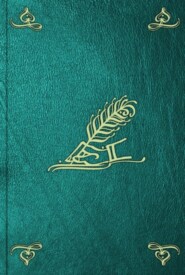По всем вопросам обращайтесь на: info@litportal.ru
(©) 2003-2024.
✖
The Amores; or, Amours
Настройки чтения
Размер шрифта
Высота строк
Поля
[ Fields of Canopus.—Ver. 7. Canopus was a city at one of the mouths of the Nile, now called Aboukir. The epithet 'genialis,' seems to have been well deserved, as it was famous for its voluptuousness. Strabo tells us that there was a temple there dedicated to Serapis, to which multitudes resorted by the canal from Alexandria. He says that the canal was filled, night and day, with men and women dancing and playing music on board the vessels, with the greatest licentiousness. The place was situate on an island of the Nile, and was about fifteen miles distant from Alexandria. Ovid gives a similar description of Alexandria, in the Tristia, Book i. El. ii. 1. 79. See the Note to the passage.]
425 (return (#x4_x_4_i9))
[ Memphis.—Ver. 8. Memphis was a city situate on the North of Egypt, on the banks of the Nile. It was said to have been built by Osirit.]
426 (return (#x4_x_4_i9))
[ Pharos.—Ver. 8. See the Metamorphoses, Book ix. 1. 772, and Book xv. 1. 287, with the Notes to the passages.]
428 (return (#x4_x_4_i9))
[ By thy sistra. —Ver. 11. For an account of the mystic 'sistra' of Isis, see the Pontic Epistles, Book i. El. i. 1. 38, and the Note.]
429 (return (#x4_x_4_i9))
[ Anubis. —Ver. 11. For an account of Anuhis, the Deity with the dog's head, see the Metamorphoses, Book ix. 1. 689, and the Note.]
430 (return (#x4_x_4_i9))
[ Osiris.—Ver. 12. See the Metamorphoses, Book ix. 1. 692, and the Note to the passage.]
431 (return (#x4_x_4_i9))
[ The sluggish serpent.—Ver. 13. Macrobius tells us, that the Egyptians accompanied the statue of Serapis with that of an animal with three heads, the middle one that of a lion, the one to the right, of a dog, and that to the left, of a ravenous wolf; and that a serpent was represented encircling it in its folds, with its head below the right hand of the statue of the Deity. To this the Poet possibly alludes, or else to the asp, which was common in the North of Egypt, and perhaps, was looked upon as sacred. If so, it is probable that the word 'pigra,' 'sluggish,' refers to the drowsy effect produced by the sting of the asp, which was generally mortal. This, indeed, seems the more likely, from the fact of the asp being clearly referred to, in company with these Deities, in the Ninth Book of the Metamorphoses, 1. 93; which see, with the Note to the passage.]
432 (return (#x4_x_4_i9))
[ The horned Apis.—Ver. 14. See the Ninth Book of the Metamorphoses, 1. 691, and the Note to the passage.]
433 (return (#x4_x_4_i9))
[ Thy features.—Ver. 15. Isis is here addressed, as being supposed to be the same Deity as Diana Lucina, who was invoked by pregnant and parturient women. Thus Isis appears to Telethusa, a Cretan woman, in her pregnancy, in the Ninth Book of the Metamorphoses, 1. 665, et seq.]
434 (return (#x4_x_4_i9))
[ Thy appointed days.—Ver. 17. Votaries who were worshipping in the temples of the Deities sat there for a considerable time, especially when they attended for the purpose of sacrifice. In the First Book of the Pontic Epistles, Ep. i. 1. 50, Ovid says, 'I have beheld one who confessed that he had offended the Divinity of Isis, clothed in linen, sitting before he altars of Isis.']
435 (return (#x4_x_4_i9))
[ On which.—Ver. 18. 'Queis' seems a preferable reading to 'qua.']
436 (return (#x4_x_4_i9))
[ The Galli.—Ver. 18. Some suppose that Isis and Cybele were the same Divinity, and that the Galli, or priests of Cybele, attended the rites of their Goddess under the name of Isis. It seems clear, from the present passage, that the priests of Cybele, who were called Galli, did perform the rites of Isis, but there is abundant proof that these were considered as distinct Deities. In imitation of the Corybantes, the original priests of Cybele, they performed her rites to the sound of pipes and tambourines, and ran to and fro in a frenzied manner.]
437 (return (#x4_x_4_i9))
[ With thy laurels.—Ver. 18. See the Note to the 692nd line of the Ninth Book of the Metamorphoses. While celebrating the search for the limbs of Osiris, the priests uttered lamentations, accompanied with the sound of the 'sistra'; but when they had found the body, they wore wreaths of laurel, and uttered cries, signifying their joy.]
438 (return (#x4_x_4_i10))
[ Ilithyia.—Ver. 21. As to the Goddess Ilithyia, see the Ninth Book of the Metamorphoses, 1. 283, and the Note to the passage.]
439 (return (#x4_x_4_i14))
[ With their bucklers.—Ver. 2. Armed with 'peltæ,' or bucklers, like the Amazons.]
440 (return (#x4_x_4_i14))
[ The sand must.—Ver. 8. This figure is derived from the gladiatorial fights of the amphitheatre, where the spot on which they fought was strewed with sand, both for the purpose of giving a firm footing to the gladiators, and of soaking up the blood that was shed.]
441 (return (#x4_x_4_i15))
[ Again throw stones.—Ver. 12. He alludes to Deucalion and Pyr-rha. See the First Book of the Metamorphoses.]
442 (return (#x4_x_4_i15))
[ Ilia had destroyed.—Ver. 16. Romulus was her son. See her story, related at the beginning of the Third Book of the Fasti.]
443 (return (#x4_x_4_i17))
[ Why pierce.—Ver. 27. He alludes to the sharp instruments which she had used for the purpose of procuring abortion: a practice which Canace tells Macareus that her nurse had resorted to. Epistle xi. 1. 40—43.]
444 (return (#x4_x_4_i18))
[ Armenian dens.—Ver. 35. See the Metamorphoses, Book viii. 1. 126, and the Note to the passage.]
445 (return (#x4_x_4_i18))
[ Many a time.—Ver. 38. He seems here to speak of this practice as being frequently resorted to.]
446 (return (#x4_x_4_i18))
[ She deserved it.—Ver. 40. From this, it would seem that the practice was considered censurable; but, perhaps it was one of those cases whose heinousness is never fully discovered till it has brought about its own punishment.]
447 (return (#x4_x_4_i22))
[ O ring.—Ver. 1. On the rings in use among the ancients, see the note to the First Book of the Aruores, El. iv., 1. 26. See also the subject of the seventh Elegy of the First Book of the Tristia.]
448 (return (#x4_x_4_i23))
[ Carpathian old man.—Ver. 10. For some account of Proteus, who is here referred to, see the First Book of the Fasti, 1. 363, and the Note.]
449 (return (#x4_x_4_i23))
[ Be able to seal—Ver. 15. From this, it appears to have been a signet ring.]
450 (return (#x4_x_4_i23))
425 (return (#x4_x_4_i9))
[ Memphis.—Ver. 8. Memphis was a city situate on the North of Egypt, on the banks of the Nile. It was said to have been built by Osirit.]
426 (return (#x4_x_4_i9))
[ Pharos.—Ver. 8. See the Metamorphoses, Book ix. 1. 772, and Book xv. 1. 287, with the Notes to the passages.]
428 (return (#x4_x_4_i9))
[ By thy sistra. —Ver. 11. For an account of the mystic 'sistra' of Isis, see the Pontic Epistles, Book i. El. i. 1. 38, and the Note.]
429 (return (#x4_x_4_i9))
[ Anubis. —Ver. 11. For an account of Anuhis, the Deity with the dog's head, see the Metamorphoses, Book ix. 1. 689, and the Note.]
430 (return (#x4_x_4_i9))
[ Osiris.—Ver. 12. See the Metamorphoses, Book ix. 1. 692, and the Note to the passage.]
431 (return (#x4_x_4_i9))
[ The sluggish serpent.—Ver. 13. Macrobius tells us, that the Egyptians accompanied the statue of Serapis with that of an animal with three heads, the middle one that of a lion, the one to the right, of a dog, and that to the left, of a ravenous wolf; and that a serpent was represented encircling it in its folds, with its head below the right hand of the statue of the Deity. To this the Poet possibly alludes, or else to the asp, which was common in the North of Egypt, and perhaps, was looked upon as sacred. If so, it is probable that the word 'pigra,' 'sluggish,' refers to the drowsy effect produced by the sting of the asp, which was generally mortal. This, indeed, seems the more likely, from the fact of the asp being clearly referred to, in company with these Deities, in the Ninth Book of the Metamorphoses, 1. 93; which see, with the Note to the passage.]
432 (return (#x4_x_4_i9))
[ The horned Apis.—Ver. 14. See the Ninth Book of the Metamorphoses, 1. 691, and the Note to the passage.]
433 (return (#x4_x_4_i9))
[ Thy features.—Ver. 15. Isis is here addressed, as being supposed to be the same Deity as Diana Lucina, who was invoked by pregnant and parturient women. Thus Isis appears to Telethusa, a Cretan woman, in her pregnancy, in the Ninth Book of the Metamorphoses, 1. 665, et seq.]
434 (return (#x4_x_4_i9))
[ Thy appointed days.—Ver. 17. Votaries who were worshipping in the temples of the Deities sat there for a considerable time, especially when they attended for the purpose of sacrifice. In the First Book of the Pontic Epistles, Ep. i. 1. 50, Ovid says, 'I have beheld one who confessed that he had offended the Divinity of Isis, clothed in linen, sitting before he altars of Isis.']
435 (return (#x4_x_4_i9))
[ On which.—Ver. 18. 'Queis' seems a preferable reading to 'qua.']
436 (return (#x4_x_4_i9))
[ The Galli.—Ver. 18. Some suppose that Isis and Cybele were the same Divinity, and that the Galli, or priests of Cybele, attended the rites of their Goddess under the name of Isis. It seems clear, from the present passage, that the priests of Cybele, who were called Galli, did perform the rites of Isis, but there is abundant proof that these were considered as distinct Deities. In imitation of the Corybantes, the original priests of Cybele, they performed her rites to the sound of pipes and tambourines, and ran to and fro in a frenzied manner.]
437 (return (#x4_x_4_i9))
[ With thy laurels.—Ver. 18. See the Note to the 692nd line of the Ninth Book of the Metamorphoses. While celebrating the search for the limbs of Osiris, the priests uttered lamentations, accompanied with the sound of the 'sistra'; but when they had found the body, they wore wreaths of laurel, and uttered cries, signifying their joy.]
438 (return (#x4_x_4_i10))
[ Ilithyia.—Ver. 21. As to the Goddess Ilithyia, see the Ninth Book of the Metamorphoses, 1. 283, and the Note to the passage.]
439 (return (#x4_x_4_i14))
[ With their bucklers.—Ver. 2. Armed with 'peltæ,' or bucklers, like the Amazons.]
440 (return (#x4_x_4_i14))
[ The sand must.—Ver. 8. This figure is derived from the gladiatorial fights of the amphitheatre, where the spot on which they fought was strewed with sand, both for the purpose of giving a firm footing to the gladiators, and of soaking up the blood that was shed.]
441 (return (#x4_x_4_i15))
[ Again throw stones.—Ver. 12. He alludes to Deucalion and Pyr-rha. See the First Book of the Metamorphoses.]
442 (return (#x4_x_4_i15))
[ Ilia had destroyed.—Ver. 16. Romulus was her son. See her story, related at the beginning of the Third Book of the Fasti.]
443 (return (#x4_x_4_i17))
[ Why pierce.—Ver. 27. He alludes to the sharp instruments which she had used for the purpose of procuring abortion: a practice which Canace tells Macareus that her nurse had resorted to. Epistle xi. 1. 40—43.]
444 (return (#x4_x_4_i18))
[ Armenian dens.—Ver. 35. See the Metamorphoses, Book viii. 1. 126, and the Note to the passage.]
445 (return (#x4_x_4_i18))
[ Many a time.—Ver. 38. He seems here to speak of this practice as being frequently resorted to.]
446 (return (#x4_x_4_i18))
[ She deserved it.—Ver. 40. From this, it would seem that the practice was considered censurable; but, perhaps it was one of those cases whose heinousness is never fully discovered till it has brought about its own punishment.]
447 (return (#x4_x_4_i22))
[ O ring.—Ver. 1. On the rings in use among the ancients, see the note to the First Book of the Aruores, El. iv., 1. 26. See also the subject of the seventh Elegy of the First Book of the Tristia.]
448 (return (#x4_x_4_i23))
[ Carpathian old man.—Ver. 10. For some account of Proteus, who is here referred to, see the First Book of the Fasti, 1. 363, and the Note.]
449 (return (#x4_x_4_i23))
[ Be able to seal—Ver. 15. From this, it appears to have been a signet ring.]
450 (return (#x4_x_4_i23))














